
-
By:
- dane
- No comment
candle wick guide
Welcome to our comprehensive guide on candle wicks! This essential resource explores the importance of wicks, their history, types, and how to choose the right one for your needs. Whether you’re a seasoned candle maker or a curious beginner, this guide will help you understand the crucial role wicks play in creating perfect burns. Learn about materials, sizes, and expert tips to enhance your candle-making journey. Discover how wax type, fragrance load, and proper maintenance ensure a clean, safe, and enjoyable burning experience. Dive in to master the art of candle wicks!
Importance of Candle Wicks
A candle wick plays a vital role in ensuring a clean, consistent, and safe burn. It regulates the flow of wax to the flame, maintaining the perfect balance between fuel and oxygen. A properly sized wick prevents issues like sooting, sputtering, or an uneven burn. Too large a wick can cause excessive smoke and residue, while too small a wick may result in a dim, ineffective flame. The wick’s quality and size directly impact the candle’s performance, longevity, and overall burning experience. By selecting the right wick, candle makers can enhance the aesthetic appeal and functionality of their creations, ensuring a smooth, hazard-free burn every time. This makes the wick an indispensable component in candle crafting, influencing both the candle’s usability and the user’s satisfaction.
Brief History of Candle Wicks
The history of candle wicks dates back thousands of years, with early civilizations using reeds or rushes as primitive wicks. Ancient Egyptians and Romans developed candles using linen or papyrus wicks dipped in animal fat. Over time, wicks evolved to cotton, which became the standard due to its consistent burn. In the Middle Ages, tallow candles with cotton wicks were common, though they produced soot. The Industrial Revolution brought mechanized spinning, enabling mass production of uniform wicks. Today, wicks are crafted from various materials like paper, wood, and metal, offering specialized burns. This evolution reflects advancements in materials and burning technology, ensuring cleaner, safer, and more efficient candles.
Role of Wick in Candle-Making
The wick plays a vital role in candle-making by regulating the flow of fuel to the flame, ensuring a consistent and controlled burn. It acts as the conduit for wax to reach the flame, melting it evenly and preventing excessive soot formation. A properly sized wick ensures the candle burns cleanly, avoiding flickering or sputtering. The wick’s material and diameter must align with the wax type and fragrance load to maintain a stable flame. Testing wicks is crucial to achieve the perfect balance, as too large a wick can cause sooting, while too small a wick may result in an insufficient flame. Suppliers often provide guides to help determine the ideal wick size for specific candle setups, making it easier to optimize the burning experience. This balance ensures a safe, efficient, and enjoyable candle-burning process.
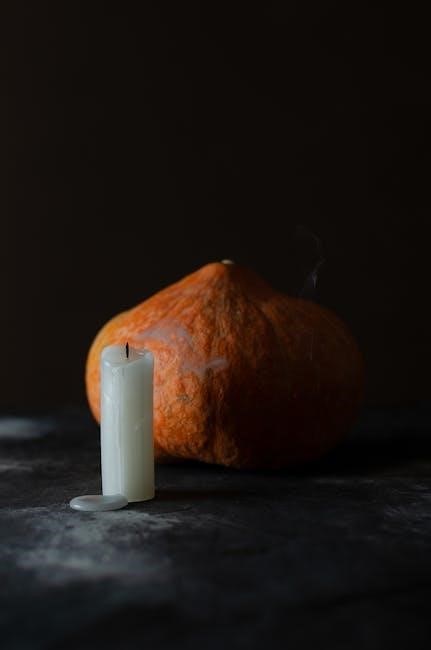
Understanding Candle Wick Types
Understanding Candle Wick Types introduces various materials and designs, such as cotton, paper, and wooden wicks, each offering unique burn characteristics and sensory experiences for candle enthusiasts.

Materials Used for Candle Wicks
Candle wicks are crafted from various materials, each offering unique burn characteristics. The most common are cotton wicks, known for their steady, consistent flames. Paper wicks are eco-friendly and often used in container candles for a clean burn. Metallic wicks, like tin or zinc, are durable and provide stability, especially in larger candles. Some specialty wicks, such as wooden ones, create a crackling sound, adding ambiance. The choice of material significantly impacts the candle’s performance, burn time, and soot production. High-quality materials ensure a safer, more efficient burn. Understanding these options helps in selecting the ideal wick for specific candle-making projects. Proper material selection is crucial for achieving the desired aesthetic and functional results in candle crafting. Always consider the wax type and intended use when choosing a wick material to optimize performance; This balance ensures a smooth, enjoyable burning experience.
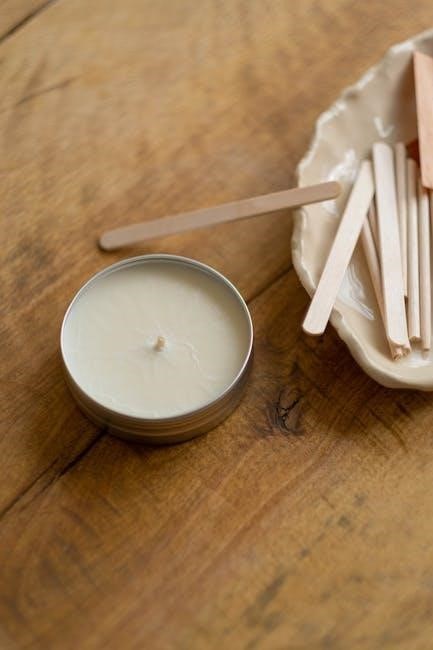
Sizes and Diameters of Candle Wicks
Sizes and Diameters of Candle Wicks
Candle wick sizes and diameters play a crucial role in ensuring a clean, even burn. The diameter of a wick is measured in inches and varies depending on the type of wax, the size of the candle, and the desired burn characteristics. Generally, wicks range from 0.125 inches for small, delicate candles to 0.375 inches or more for large, robust flames. The right wick size ensures proper fuel flow, preventing issues like sooting or uneven burning. Too small a wick may result in a dim, flickering flame, while too large a wick can cause excessive soot or an unstable burn. Many suppliers provide size guides to help match wicks to specific candle containers and wax types. Testing different wick sizes is often necessary to achieve the perfect burn for your unique candle creation.
Flat vs. Cored vs. Paper Wicks
When it comes to candle wicks, the choice between flat, cored, and paper wicks depends on the desired performance and candle type. Flat wicks, made from a single strand of fiber, are ideal for container candles and provide a consistent burn. Cored wicks, featuring a central core for stability, are often used in votive or tealight candles, ensuring an even melt pool. Paper wicks, eco-friendly and noise-producing, are popular in wooden wick candles for a soothing crackling sound. Each type addresses specific needs, such as burn rate, stability, and ambiance, making them suitable for different candle-making projects. Understanding these differences helps in selecting the right wick for optimal results.
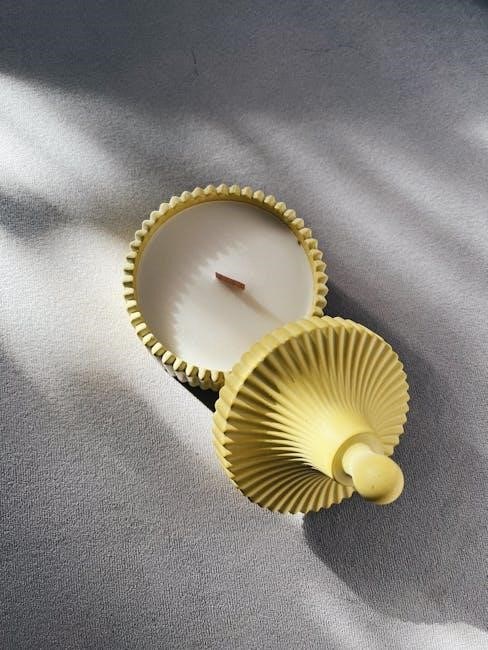
How to Choose the Right Wick
Selecting the ideal wick involves considering wax type, candle size, fragrance load, and burn testing. Match wick size to container diameter and wax properties for optimal performance and safety.
Factors Influencing Wick Selection
Selecting the right candle wick involves considering several key factors to ensure optimal performance. The
Wax Type and Its Impact on Wick Choice
The type of wax used in candle-making significantly influences the choice of wick. Different waxes have varying hardness, melting points, and oil content, which affect how the wick performs. For example, soy wax, being softer and more prone to sooting, often requires a smaller wick diameter to ensure a clean burn. Beeswax, with its hard and brittle nature, may need a slightly larger wick to maintain an even flame. Paraffin wax, the most common type, offers flexibility but still demands precise wick sizing to avoid sputtering or incomplete combustion. Additionally, blended waxes may require tailored wick selections to balance their unique properties; The wax’s fragrance load capacity also plays a role, as higher fragrance levels can overwhelm a wick that is too small. Consulting wick guides from suppliers and conducting burn tests are essential steps to match the right wick to your wax type for optimal performance.
Candle Size and Shape Considerations
Candle size and shape play a significant role in determining the appropriate wick size. Larger candles with wider diameters typically require thicker wicks to ensure a clean, even burn, while smaller candles need thinner wicks to prevent excessive flame height. The shape of the candle, such as tapered, pillar, or votive, also influences wick selection. For example, container candles may require wicks that are specifically designed to fit snugly within the vessel, ensuring proper wax pooling. The height of the candle can also affect the wick’s performance, as taller candles may need longer wicks to maintain a consistent flame. Additionally, the density of the wax and the desired burn time are factors to consider when matching wick size to candle dimensions. Proper sizing ensures optimal performance, preventing issues like incomplete melting or sooting. Always consult wick charts or manufacturer guidelines for specific recommendations based on your candle’s unique dimensions and wax type.
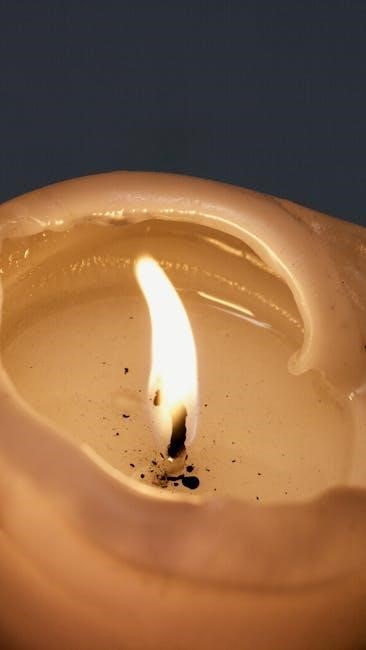
Fragrance Load and Wick Size
Fragrance load significantly influences wick size selection. A higher fragrance load requires a larger wick to ensure proper combustion, as the fragrance oil increases the fuel available to the flame. Too small a wick may result in an incomplete burn, leading to soot formation. Conversely, a wick that is too large can cause excessive heat, sputtering, or an unstable flame. The ideal wick size balances the fragrance load with the wax type and candle size, ensuring a clean, even burn. Testing different wick sizes with varying fragrance loads is crucial to achieve optimal performance. Proper alignment of fragrance load and wick size enhances the candle’s safety, appearance, and overall burning experience, making it essential for candle makers to carefully consider these factors during production.
Conducting Burn Tests
Burn tests are crucial for ensuring a candle burns cleanly and evenly. Start by preparing a well-ventilated space and lighting the candle, observing the flame size and stability. Monitor how the wax melts and the wick performs over time. Note any issues like sooting or sputtering. Test multiple wick sizes and types to find the optimal fit for your wax and fragrance combination. Record the burn time and adjust as needed to achieve a consistent, smoke-free flame. Regular testing helps prevent hazards and ensures a safe, enjoyable burning experience. Proper burn tests are key to perfecting your candle-making craft and delivering high-quality results.

Common Candle Wick Challenges
Common candle wick challenges include sooting, inconsistent burns, and wick sputtering. Addressing these issues requires optimizing wick size, material, and wax compatibility for a clean, even flame.
Sooting Issues and Solutions
Sooting is a common issue in candle burning, often caused by an improper wick size or type for the specific wax used. When the wick is too large, it can produce excessive smoke and soot, creating an unpleasant burning experience. Additionally, high fragrance loads or poor wax quality can exacerbate sooting. To address this, ensure the wick size aligns with the wax type and candle dimensions. Using a wick specifically designed for your wax, such as cotton, paper, or cored wicks, can significantly reduce sooting. Regular wick trimming to the recommended length (typically 1/4 inch) also helps maintain a clean burn. If sooting persists, consider conducting burn tests with different wick sizes or switching to a wax with lower soot tendencies. Proper wick maintenance and selection are key to achieving a soot-free, enjoyable candle experience.
Wick Sputtering and Remedies
Wick sputtering occurs when a candle’s flame flickers unpredictably, causing the wick to spit or emit sparks. This issue often arises from an improperly sized wick or uneven wax melting. To resolve this, ensure the wick is appropriately matched to the candle’s wax type and size. Testing different wick sizes can help find the ideal fit. Additionally, using a wick with a stabilizing core or switching to a different wax type may reduce sputtering. Regular wick trimming and avoiding drafts can also improve burn stability. If the problem persists, consider consulting a wick guide or conducting burn tests to identify the root cause. Proper wick selection and maintenance are key to achieving a smooth, consistent flame.
Optimizing Wick Size for Clean Burn
Optimizing wick size is crucial for achieving a clean, consistent burn. A wick that’s too large can cause excessive soot, while one that’s too small may result in a dim, flickering flame. Always test different wick sizes to find the perfect balance for your candle. The wax type and fragrance load significantly influence this process, as thicker waxes and higher fragrance concentrations often require larger wicks. Monitor the flame height and burn pool during testing; a clean burn should have a steady, even flame with minimal soot. Proper wick size ensures efficient fuel combustion, reducing waste and enhancing the overall burning experience. Regularly trimming the wick to the recommended length further maintains optimal performance. Remember, the right wick size is key to a safe, clean, and enjoyable candle-burning experience.
Specialty Candle Wicks
Specialty candle wicks, like wooden, metallic, and eco-friendly options, offer unique features. Wooden wicks create a soothing crackle, while metallic wicks add visual flair. Eco-friendly choices promote sustainability, enhancing the candle experience.

Wooden Wicks and Their Unique Sound
Wooden wicks are a unique innovation in candle-making, offering a distinctive crackling sound during burning, reminiscent of a fireplace. Unlike traditional cotton or paper wicks, wooden wicks create a sensory experience with their audible appeal. Crafted from natural wood, these wicks are often used in specialty candles to evoke a cozy, rustic ambiance. The sound is caused by the wood’s natural fibers reacting to the flame, creating a soothing crackle. Wooden wicks are particularly popular in seasonal or themed candles, adding an extra layer of charm. However, they require specific wax blends and burn conditions to function optimally. Proper wick maintenance, such as trimming, is crucial to ensure consistent performance. Wooden wicks are eco-friendly and offer a unique twist, making them a favorite for those seeking a candle experience beyond the ordinary.
Metallic Wicks for Special Effects
Metallic wicks add a unique touch to candles, offering visual effects like colorful sparks or a dramatic flame. These wicks are made from durable materials such as stainless steel or other heat-resistant metals, designed to create a striking visual experience. Unlike traditional wicks, metallic ones are engineered to withstand high temperatures without melting, making them ideal for specialty candles. They are often used in decorative or themed candles to enhance ambiance and create a luxurious feel. While they can be more challenging to trim and maintain, metallic wicks provide a distinctive appeal that sets candles apart. However, they may produce soot if not properly designed, so careful selection and use are essential. For those seeking a visually captivating candle, metallic wicks offer an extraordinary option to elevate the burning experience.
Eco-Friendly Wick Options
Eco-friendly wick options are gaining popularity as consumers seek sustainable and environmentally conscious candle-making solutions. Paper wicks, made from natural, biodegradable materials, are a popular choice for their clean burn and minimal soot production. Bamboo wicks, another eco-friendly alternative, are durable and sustainably sourced, offering a unique aesthetic. Wooden wicks, though not entirely eco-friendly, are often paired with soy wax for a greener option. These options reduce environmental impact while maintaining performance. Many candle makers are shifting to these materials to align with green values and meet consumer demand for sustainable products. Eco-friendly wicks not only promote a cleaner burn but also support ethical manufacturing practices, making them a preferred choice for environmentally aware crafters and buyers alike.

Candle Wick Maintenance Tips
Proper wick maintenance ensures optimal candle performance. Regularly trim and clean wicks to prevent soot buildup and promote a clean, even burn for safer, longer-lasting candles.
Trimming Wicks for Better Performance
Trimming candle wicks is a simple yet crucial step for optimal burning performance. It ensures a clean, steady flame and prevents sooting or uneven burning. Always trim the wick to 1/4 inch before lighting to maintain control over the flame size and heat output. This practice also reduces carbon buildup, which can interfere with the burn quality. Regular trimming helps prevent the wick from becoming too long and causing the candle to produce excessive smoke or flicker dangerously. For best results, trim the wick after each use and before relighting, especially if soot has accumulated. This maintenance routine not only enhances the candle’s efficiency but also prolongs its lifespan. By keeping the wick well-trimmed, you ensure a safer, cleaner, and more enjoyable burning experience every time.
Cleaning Wicks for Reuse
Cleaning candle wicks for reuse is a simple yet effective way to extend their lifespan and ensure optimal performance. Start by allowing the wick to cool completely after use. Gently remove any debris or residue using a soft cloth or cotton ball. For stubborn soot or wax buildup, dip the wick in warm water or a mild soap solution, then rinse thoroughly. Avoid harsh chemicals, as they may damage the wick material. Once clean, lay the wick flat to dry completely before reusing it. Regular cleaning prevents the accumulation of impurities that can affect burn quality. This eco-friendly practice not only saves resources but also maintains the wick’s efficiency for future burns.
Candle Safety and Wick Care
Ensure a safe burning experience by preventing wick-related hazards. Avoid soot buildup and sputtering by maintaining proper fuel balance. Always trim wicks to 1/4 inch for a clean burn.
Preventing Wick-Related Hazards
To ensure a safer candle-burning experience, it’s crucial to prevent wick-related hazards. Always trim the wick to the recommended length before lighting to avoid an overly large flame, which can lead to soot buildup and potential fires. Choose the
Best Practices for Burning Candles
For a safe and enjoyable candle-burning experience, always trim the wick to 1/4 inch before lighting to prevent excessive flame height and soot formation. Place candles on stable, heat-resistant surfaces away from drafts and flammable materials. Never leave burning candles unattended or near children or pets. Allow the wax pool to reach the edge of the container each time you burn the candle to ensure an even burn and prevent tunneling. Avoid burning candles for more than 4-6 hours at a time, as this can cause the wick to become unstable. Keep the wick centered and upright to maintain a clean, consistent burn. Always extinguish the flame gently, as blowing it out can cause splattering. By following these best practices, you can enjoy your candles safely while maximizing their performance and longevity.
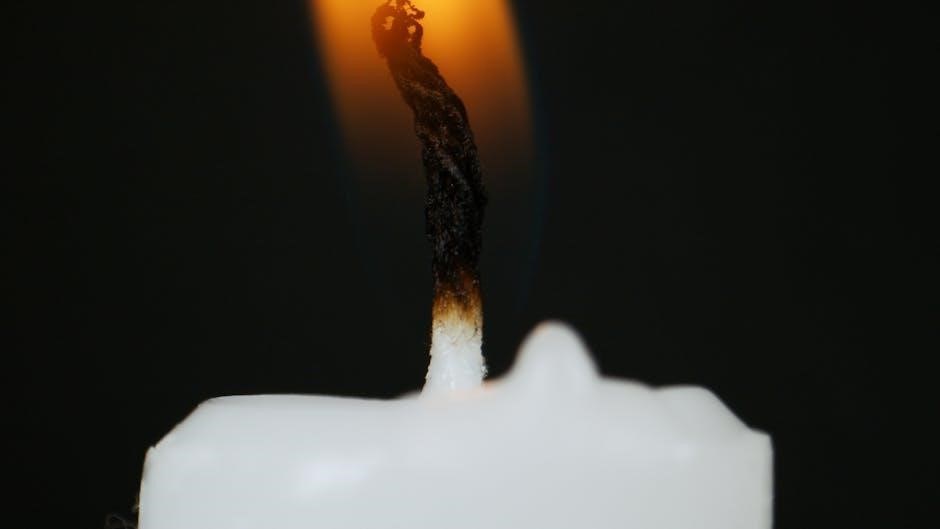
This guide has covered the essential aspects of candle wicks, from their history and materials to selection and maintenance. Key considerations include wax type, wick size, and fragrance load, which influence burn quality. Proper wick trimming and cleaning ensure safety and performance. Conducting burn tests is crucial for optimizing wick size. Additionally, specialty wicks like wooden and eco-friendly options offer unique benefits. By understanding these factors, candle makers can create safer, cleaner-burning candles. Always prioritize wick maintenance and follow safety guidelines to enhance your candle-making experience. For further learning, explore recommended resources and tools to deepen your expertise in candle wick selection and care.
Recommended Reading and Tools
To deepen your understanding of candle wicks, explore these recommended resources and tools. Start with “The Candle Maker’s Guide” by Betty Bijoor, which offers detailed insights into wick selection and candle crafting. Online platforms like CandleScience and Bramble Berry provide extensive wick guides, charts, and calculators to simplify your process. For hands-on learning, consider enrolling in candle-making workshops or webinars hosted by experts. Additionally, join candle-making communities on forums like Reddit or Facebook groups to share tips and troubleshoot challenges. Essential tools include a wick trimmer, a melting pot, and a wick tester to ensure optimal burns. These resources will empower you to master the art of candle wicks and create professional-quality candles with ease and confidence.